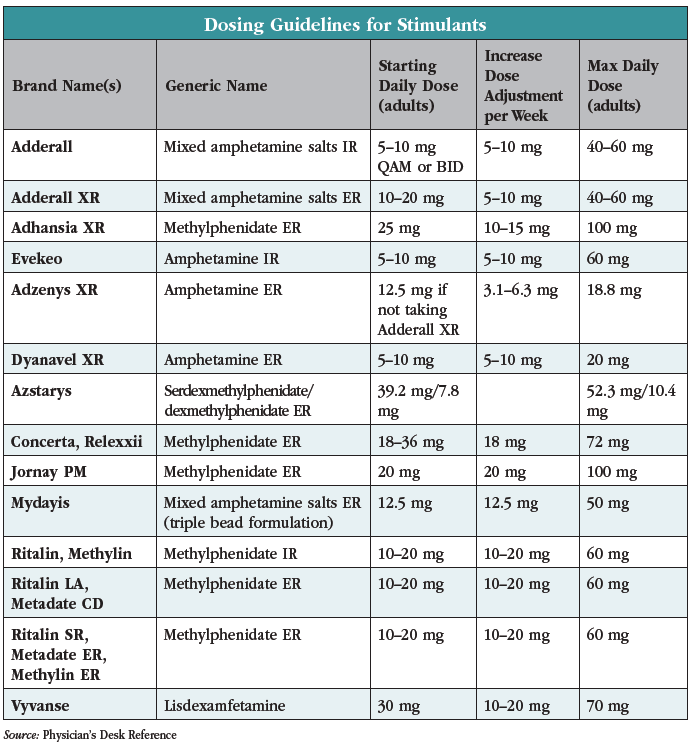Stimulant Dosing Limits
“Amanda” is an engineering student with ADHD. After six years of treatment, she says her current dose of Adderall XR (40 mg) does not work like it used to. You note that 40 mg daily is the listed FDA maximum daily dosage of Adderall, and you are unsure whether to increase the dose or not.
Stimulant dosing presents a unique challenge. These medications are inherently rewarding, which means we can’t take a purely collaborative approach and let patients guide the dose. On the other hand, the safe upper limits are not always clear despite the strict Schedule II status the DEA has placed the medications in. In this article, we’ll look at where to draw the lines and the risk of dosing too high.
What’s wrong with going higher?
A higher dose raises the risk of abuse and diversion, as well as cardiovascular problems like hypertension, stroke, and myocardial infarction. It may even worsen cognition, either by disrupting sleep or causing a hyperfocused state that makes it difficult for the patient to shift gears and change tasks.
Psychiatric symptoms like psychosis and mania become more likely as the dose inches up. When patients with narcolepsy took high doses of stimulants (approximately double the FDA maximum), it raised their risk of psychosis (12-fold), psychiatric hospitalization (three-fold), and substance abuse (four-fold), according to a study that compared outcomes in high and low doses (Auger RR et al, Sleep 2005;28(6):667–672).
Animal models flag caution regarding the dosing of stimulants, particularly the amphetamines. Studies with baboons have shown damage in striatal dopaminergic terminals on elevated doses of amphetamines, equivalent to 60 mg/day and above in human dosing (Ricaurte GA et al, J Pharmacol Exp Ther 2005;315(1):91–98). At higher doses, animal studies reveal neurotoxic damage to dopaminergic neurons in the caudate putamen (Moratalla R et al, Prog Neurobiol 2017;155:149–170).
Amphetamines
The FDA sets the maximum for Adderall (IR or XR) at a dose of 40 mg/day for adult ADHD. However, they allow up to 60 mg/day for more severe cases of ADHD, as well as for narcolepsy. That 40–60 mg max was derived from a large registration trial of adult ADHD. The study compared three doses of Adderall XR (20, 40, and 60 mg/day), and found no significant difference between them in terms of safety and efficacy (Weisler RH et al, CNS Spectr 2006;11(8):625–639). There was some evidence that people with more severe ADHD did better on the higher doses of 40–60 mg, but that finding was limited due to its secondary, “data-fishing” nature.
We recommend thinking of the dose in three zones: the safe zone (below 40 mg/day), the gray zone (40–60 mg/day), and the danger zone (above 60 mg/day). Going up to 60 mg/day may be justified when the symptoms are severe, but you’d want to document their presence on the mental status exam and verify that the ADHD is affecting the patient’s functioning. We are not aware of research justifying a dose above 60 mg/day, which would land in the danger zone.
Higher doses may also be justified when a longer duration is needed. Mydayis (a very extended-release version of Adderall) has a maximum dose of 50 mg, but this leads to similar plasma levels as Adderall XR 40 mg because the dose is spread out over 16 hours instead of 12. When extending the duration, make sure the patient is getting adequate sleep so they are not relying on the stimulant for symptoms of sleep deprivation.
 Methylphenidates
Methylphenidates
For methylphenidate, the FDA gives a clear maximum, although it varies slightly by formulation. That max is 60 mg/day for methylphenidate IR (Ritalin), but higher doses are allowed for products with longer durations such as Concerta (72 mg over 12 hours) and Adhansia (100 mg over 16 hours).
A few methylphenidate products have lower dose caps because more of the drug is absorbed. These include the transdermal formulation (Daytrana is given at half the usual methylphenidate dose) and orally disintegrating tablets (Cotempla ODT is dosed at 86% of the usual dose and Adzenys ODT at 65%).
Dosing in the elderly
Adult ADHD is a relatively new concept, and geriatric ADHD is newer still. The middle-aged patients who started stimulants 20 years ago—when the FDA first approved them in adults—are now entering their retirement years with little data to guide them. There are no controlled trials in patients with ADHD after age 50, but a few observational studies suggest older adults continue to benefit, although at lower doses (eg, average doses of 30 mg/day for methylphenidate and 10 mg/day for amphetamine and dextroamphetamine) (Michielsen M et al, J Atten Disord 2021;25(12):1712–1719).
There are three reasons to consider lowering the dose as patients age. Older adults are more susceptible to the cardiovascular effects and—based on animal data—the neurotoxic effects of stimulants. In animal models, the same dose of amphetamine reached twice the levels in the brains of older rats compared to younger ones, suggesting that older adults may not need as high a dose to achieve a good response (Berman SM et al, Mol Psychiatry 2009;14(2):123–142).
Drug interactions
The amphetamines are a major substrate of CYP2D6, so strong CYP2D6 inhibitors (which include bupropion, duloxetine, fluoxetine, and paroxetine) may push the dose even higher. Most stimulants are not significantly affected by food interactions, but Adderall XR may not be absorbed as well when taken with a large, fatty meal.
Practical steps
Back to our case. Going beyond 40 mg/day of Adderall would land us in the gray zone for this student. Before taking that step, we should verify that her ADHD is causing significant functional impairment and rule out other causes such as sleep deprivation or depression. Besides raising the dose, evidence also supports augmenting with guanfacine or switching to a different amphetamine mixture (eg, dextroamphetamine, lisdexamfetamine). If—after discussing risks and benefits—we decide to raise the dose, we should track her progress with a rating scale such as the Adult ADHD Self-Report Scale (ASRS-v1.1; www.tinyurl.com/376mav49).
CARLAT VERDICT
With psychostimulants, it’s best to stay within the FDA-approved limits. Slightly higher doses of mixed amphetamine salts (Adderall, up to 60 mg/day) may be needed for patients with severe symptoms, and lower doses are likely safer and just as effective in the elderly.
Related content
A Balanced Approach to Treating ADHD
Stimulants: The Case for Caution



_-The-Breakthrough-Antipsychotic-That-Could-Change-Everything.webp?t=1729528747)



